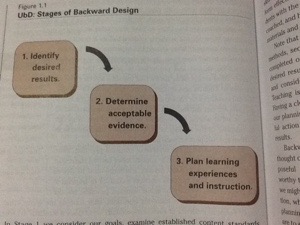I have started reading Understanding by Design by Grant Wiggins and Jay McTighe (2005)(this edition on Amazon). The phrase “backward design” has been floating around discussions of curriculum design for a while now, both on the ground at my school and ‘out there’, on the interwebs. This concept is not really new to me; I have read a bit here-and-there, following up on links from conference sessions, and have used similar strategies through various professional learning experiences (Intel in Education course, 2005, springs to mind – infusing technology into the curriculum by starting with the Essential Question and working back from there- review paper available here). However this is the first time I have sat down to read a textbook on the topic.
First impressions: this approach dovetails quite nicely with how I plan units of work. I think it will help me refine my techniques, and to be more explicit in sharing learning goals with students. I also like the quiet humour showing up here and there – always makes it easier to read a densely-packed serving of information when it is lightened a little with appropriate puns!

